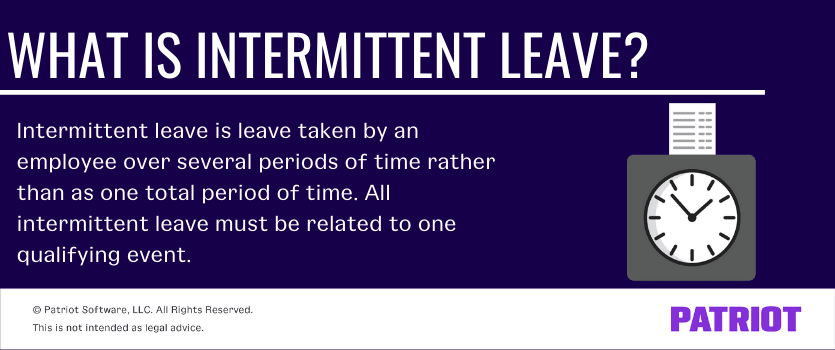When an employee comes to you to request time off, you may start asking yourself what kinds of leave you should offer. Perhaps you have a paid time off (PTO) policy. Or maybe your state has paid sick leave laws you must follow. You may also need to provide Family Medical Leave Act (FMLA) leave to qualified employees. Depending on why your employee needs the leave, they may need to take intermittent leave. So, what is intermittent leave?
What is intermittent leave?
Sometimes, employees need to use all of their leave in one chunk of time. In that case, the employee must use continuous leave.
But, employees may have circumstances that require them to take leave in smaller increments of time. This is where intermittent leave comes into play. With intermittent leave, an employee can take leave for one qualifying event in smaller periods.

The FMLA has rules about continuous and non-continuous leave and protects a worker’s job if they need to take time off work for qualifying reasons. You can require employees to use all of their available PTO before using FMLA intermittent leave. Keep in mind that all leave under the FMLA is unpaid.
State paid sick leave laws typically do not include intermittent leave policies. If applicable, check with your state to find out whether its paid sick leave law includes intermittent leave rules.
If your business is in a state that requires paid family leave (PFL), you must comply with the state’s policy on intermittent leave (if applicable).
FMLA qualifying events
So, how does FMLA intermittent leave work? Again, employees can only take this type of leave for a single qualifying event. The FMLA sets strict rules on when an employee qualifies.
A single qualifying event includes:
- Time off for a serious health condition that limits an employee’s ability to perform essential job functions
- Caring for an immediate family member (spouse, child, or parent—but not a parent “in-law”) with a serious health condition
- The birth, adoption, or foster placement of a child
- A situation that requires attention because of the military deployment of a spouse, child, or parent
- Care related to a serious illness or injury for a covered servicemember who is the spouse, parent, or child of an employee
As with continuous leave, the maximum amount of time available for intermittent leave is generally 12 weeks total throughout the year. An employee can use a total of 26 weeks of unpaid intermittent leave during a 12-month period for the care of an injured or ill servicemember but not for the deployment.
Qualifying events must require periodic or episodic care for the same reason. For example, an employee may take intermittent leave for all doctor appointments associated with treatment for a serious health condition (e.g., chemotherapy for cancer). Employees may not use FMLA intermittent leave for multiple qualifying events (e.g., the birth of a child and a serious illness).
What is a serious health condition?
Not all health conditions qualify an employee for non-continuous leave. Serious health conditions include the following:
- Conditions that require an overnight stay in a medical care facility or hospital
- Any condition that makes an employee or their family member unable to work or attend school for more than three consecutive days
- Illnesses or conditions that require ongoing medical treatment, including multiple appointments with a healthcare provider or single appointments with prescription follow-up care
- Chronic conditions causing occasional periods of incapacitation that require treatment at least twice a year with a healthcare professional
Employees who donate an organ to a non-relative may use intermittent leave for the operation and postoperative care.
Reduced leave
Your employees may also use FMLA on a reduced leave schedule, which is separate from an intermittent leave of absence. Reduced leave is when you reduce an employee’s usual weekly or daily work schedule. Your employee must work with you to schedule their reduced leave so they do not disrupt business operations.
Intermittent leave for pregnancy
Employees may also use FMLA intermittent leave for pregnancy-related reasons such as:
- Prenatal medical appointments
- Incapacity due to morning sickness
- Medically-required bed rest on healthcare provider orders
Again, the FMLA allows employees to use intermittent leave for the birth of a child, placement of a foster child, or adoption. Employees can only use intermittent leave for these reasons with employer approval. An employee must use intermittent leave within 12 months of the child’s birth or placement.
Employer responsibilities for FMLA intermittent leave
Intermittent FMLA guidelines set specific regulations for employers. Under intermittent FMLA, you can:
- Temporarily move an employee to an alternative position with equivalent pay and benefits when the employee uses leave
- Request a medical certification from your employee to support the reason for leave within five days. Employees have 15 calendar days to present the medical certificate
- Ask an employee to obtain a second or third medical opinion if you have reason to believe the original medical certification is invalid. If you ask your employee to get a second or third opinion, you must pay for the opinion at your own expense
- Have employees sign fitness-for-duty certifications upon their return to work if you have a policy regarding fitness-for-duty for all employees. Certificates should be from the employee’s medical provider
State policies for intermittent leave
You may live in a state with paid family leave. The following states have PFL laws:
- California
- Colorado (coming soon)
- Connecticut
- D.C.
- Massachusetts
- New Jersey
- New York
- Oregon (coming soon)
- Rhode Island
- Washington
In most cases, the employees pay for the PFL program through taxes deducted from their paychecks. However, employers may also need to contribute to a portion of the tax. Typically, employees must notify you of the need for PFL and apply directly with the state for paid leave.
Some states with PFL allow employees to combine medical and family leave for longer periods (e.g., Washington state). For example, an employee in Washington can use 12 weeks for medical or family leave. An employee can use up to 16 weeks of combined family and medical leave for more than one qualifying event in the claim year. Employees can also use up to 18 weeks of combined PFL for pregnancy-related reasons, such as bed rest or delivery of a child.
If your state does not require PFL but has its own unpaid family leave laws (e.g., Vermont), follow the state’s laws on intermittent leave.
Keep in mind that employees who are not eligible for state PFL may still qualify for FMLA.
Check your state’s laws regarding intermittent leave for more information.
Tracking time off for your employees shouldn’t take longer than the time it takes for them to return to work. Patriot’s online payroll and time and attendance add-on work together to help save you time and money so you can get right back to business. Try it free for 30 days!
This is not intended as legal advice; for more information, please click here.


